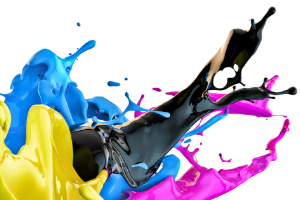~ by Walter Zacharias, Quality Assurance Leader of think4D

At its core, color is a fascinating interplay of perception and physics. Our eyes act as sensors, detecting electromagnetic radiation, which our brain then interprets into a rich spectrum of hues, shades, and brightness levels.
Over the last century, scientists and researchers have made significant strides in developing instruments capable of quantifying color relative to our human perceptions. These advancements allow us to communicate specifics about color using numeric data, including precise differences between two colors.

However, despite the usefulness of numerical values, our perception of color remains intricate and multifaceted. One critical aspect that these numbers often overlook is the sheen of a color sample. For instance, the same ink applied to different substrates—such as uncoated paper versus coated paper vs white plastic vs clear plastic—can yield vastly different visual results. Why? Because the sheen varies significantly. It’s like comparing a matte finish to a glossy one. The ink’s interaction with the substrate plays a pivotal role in shaping the final colour appearance.
Creating a perfect simulation of flexographic spot color ink reverse-printed on a plastic substrate presents significant challenges. Imagine using an inkjet printer on custom-coated paper to achieve this simulation—it’s a complex task. Factors like ink absorption, surface texture, and substrate interactions all play a role in shaping the final color appearance.

To address these complexities, process color printing relies on a combination of four primary ink colors: Cyan, Magenta, Yellow, and Black (CMYK). By skillfully blending these colors, designers can simulate a wide range of hues. This approach offers several advantages, including cost-effectiveness and efficiency.
However, this process introduces more variables. Achieving consistent results across different print runs and substrates becomes a delicate balancing act. It requires expertise, meticulous control, and some artistic flair.
An additional challenge arises when brand-specific colors are used for large design elements, such as bands around packaging or background areas on labels. Our eyes are remarkably sensitive to these substantial color blocks, making precise color matching crucial for maintaining brand identity and visual impact.
In summary, colour is both science and art. Whether you’re designing for print, web, or packaging, understanding specific nuances ensures that your colours resonate with your audience and convey the intended message.

Let think4D help you navigate the complexities of your packaging…we’re just a quick email away!